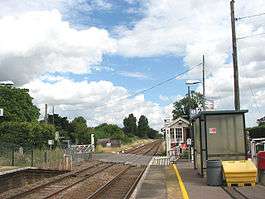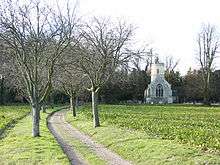Eccles Road railway station
| Eccles Road | |
|---|---|
 | |
| Location | |
| Place | Quidenham |
| Local authority | Breckland |
| Grid reference | TM018900 |
| Operations | |
| Station code | ECS |
| Managed by | Abellio Greater Anglia |
| Number of platforms | 2 |
| DfT category | F2 |
|
Live arrivals/departures, station information and onward connections from National Rail Enquiries | |
| Annual rail passenger usage* | |
| 2010/11 |
|
| 2011/12 |
|
| 2012/13 |
|
| 2013/14 |
|
| 2014/15 |
|
| History | |
| 30 July 1845 | Opened |
| 18 April 1966 | Closed to freight |
| National Rail – UK railway stations | |
| * Annual estimated passenger usage based on sales of tickets in stated financial year(s) which end or originate at Eccles Road from Office of Rail and Road statistics. Methodology may vary year on year. | |
|
| |
Eccles Road railway station is on the Breckland Line in the east of England, serving the villages of Eccles, Quidenham and Wilby in Norfolk. The line runs between Cambridge in the west and Norwich in the east.
Eccles Road is situated between Harling Road and Attleborough, 104 miles 36 chains (168.1 km) down-line from London Liverpool Street via Ely. The station is managed by Abellio Greater Anglia, which also operates most of the services calling at the station. Some East Midlands Trains also stop at Eccles Road.
The station takes its name from the now abandoned original village of Eccles that was located one mile south of the station. The church Eccles St. Mary still stands and is one of 124 original round-tower churches in Norfolk. In the 1990s, a new village was built immediately adjacent to the station, and this now bears the names of Eccles. This makes the "Road" suffix in the station's name an anachronism. The station is situated in the civil parish of Quidenham, about 2 miles (3 km) north of the village of Quidenham, and 1 mile (1.5 km) north-east of Snetterton Motor Racing Circuit.[1]
The station is unstaffed and has two platforms, adjacent to a level crossing. Wooden level crossing gates used to be opened and closed manually by a signaller in the local signal box, which is dated 1883. However, in 2012 the signal box was closed and the crossing was renewed with automatic barriers controlled from Cambridge. The redundant signal box stands across the road from the westbound (Cambridge) platform, but is expected to be demolished when the barriers are replaced in 2017.
History
The Bill for the Norwich & Brandon Railway (N&BR) received Royal Assent on 10 May 1844. The line was to link with an Eastern Counties Railway (ECR) project of a line from Newport in Essex to Brandon in Norfolk. Once complete the line would enable trains to travel from Norwich to London. Work started on the line in 1844.
One month before the N&BR opened a Bill authorising the amalgamation of the Yarmouth & Norwich Railway with the N&BR came into effect and so Eccles Road station became a Norfolk Railway asset.[1]
The line opened on 30 July 1845 including the ECR Brandon to Newport line. However, the line only got to Trowse, in the suburbs of Norwich, as the contractors were having to build a swing bridge to cross the navigable River Wensum. Eccles Road station was, when opened, between Roudham (Ely direction) and Attleborough (Norwich direction).
The ECR and its rival the Eastern Union Railway (EUR) were both sizing up the NR to acquire and expand their railway empire. The ECR trumped the EUR by taking over the NR, including Eccles Road Station on 8 May 1848.
In the September of the following year the ECR decided to rename Harling Station as Harling Road.
By the 1860s the railways in East Anglia were in financial trouble, and most were leased to the Eastern Counties Railway, which wished to amalgamate formally but could not obtain government agreement for this until an Act of Parliament on 7 August 1862, when the Great Eastern Railway (GER) was formed by the amalgamation. Actually, Eccles Road became a GER station on 1 July 1862 when the GER took over the ECR and the EUR before the Bill received the Royal Assent.[4]<CJ Allen - Great Eastern - page46>
The system settled down for the next 6 decades, apart from the disruption of First World War. The difficult economic circumstances that existed after World War 1 led the Government to pass the Railways Act 1921 which led to the creation of the Big Four. The GER was absorbed into the London & North Eastern Railway (LNER). Eccles Road became a LNER station on 1 January 1923.
A generation later, in 1947, the Government of the day passed the Transport Act which nationalised the Big Four and created British Railways (BR). On 1 January 1948 Eccles Road became a BR station.
40+ plus years after nationalisation the Government of the day passed the Railways Act 1993 which privatised the ownership and management of the track on 1 April 1994.
Three years after Railtrack took over the track, on 5 January 1997 train services serving Eccles Road were privatised with most services passing to Anglia Railways and services towards the West Midlands were taken over by Central Trains on 2 March 1997.
5 years after the train operating companies took over (2002) the infrastructure company got into serious problems following serious train accidents where poor track maintenance was to blame, Hatfield was the most notorious. So, the Government of the day restructured Railtrack and formed a new company called Network Rail.
Two years after Railtrack disappeared, on 1 April 2004 Anglia trains handed over their franchise to National Express-East Anglia (NE-EA). NE-EA trains were branded as One. Three years later, on 11 Nov 2007 the Central Trains franchise was broken up and services to Norwich were taken over by East Midland Trains who still run that franchise today (Feb-2016).
Four years (2008) after NE-EA took over train services the "One" brand was dropped and the National Express name predominated. One year later (2009) deep into the financial recession, NX walked away from the East Coast franchise and so the Government announced that the NX-EA franchise would not be extended for three years in 2011.
The Coalition Government did give short extensions to NX-EA until Feb 2012. By then the Government granted the franchise to Abellio-Greater Anglia (AGA). AGA took over on 5 Feb 2012 and was extended to October this year (2016).
Last year (2015) the Government nationalised Network Rail so only the Train Operating Companies remained private.
Services
As of December 2015, on weekdays there are two westbound trains per day, one operated by East Midlands Trains which calls at Harling Road, Thetford and Ely before continuing on to Liverpool Lime Street, the other operated by Abellio Greater Anglia which runs to Cambridge, also calling at all intermediate stations on the line except Lakenheath and Shippea Hill. On Saturdays there are two westbound trains, both operated by Abellio Greater Anglia to Cambridge with the same calling pattern.
In the eastbound direction, from Monday to Saturday there are two trains per day to Norwich calling at all intermediate stations except Spooner Row, both operated by Abellio Greater Anglia.[2]
There is no Sunday service.
References

External links
- Map sources for Eccles Road railway station
- Train times and station information for Eccles Road railway station from National Rail
| Wikimedia Commons has media related to Eccles Road railway station. |
| Preceding station | Following station | |||
|---|---|---|---|---|
| Abellio Greater Anglia | ||||
| East Midlands Trains Limited services |
Coordinates: 52°28′14″N 0°58′11″E / 52.47062°N 0.96961°E